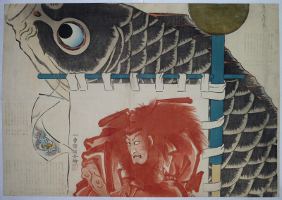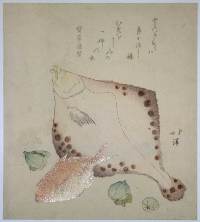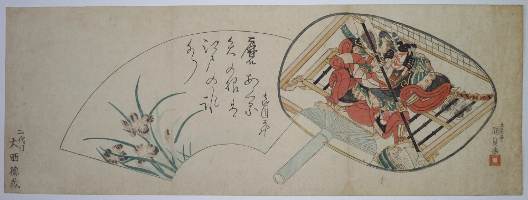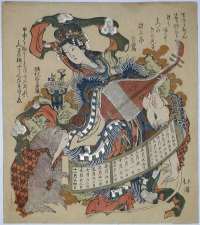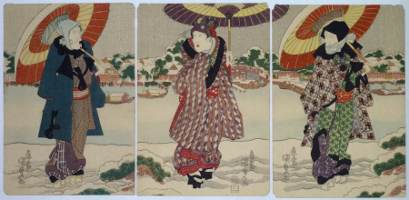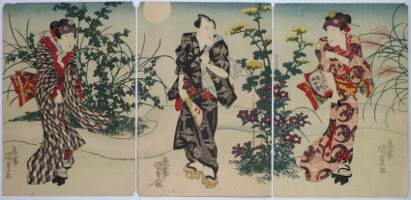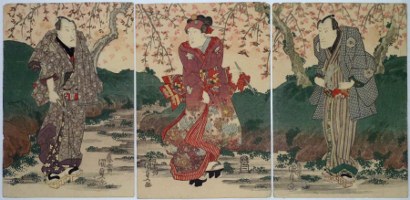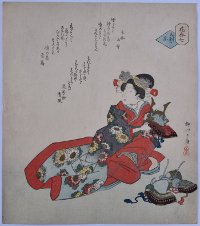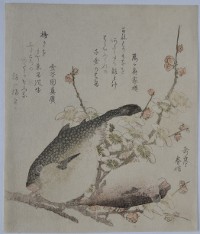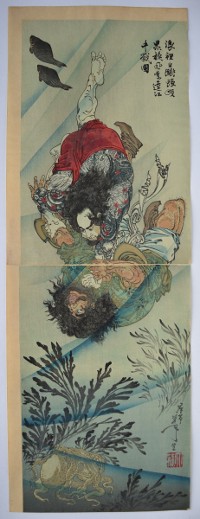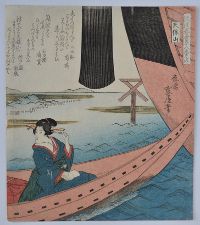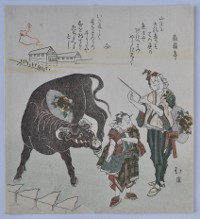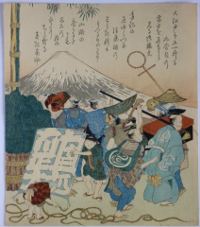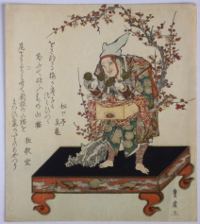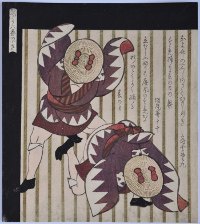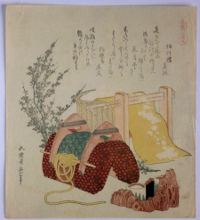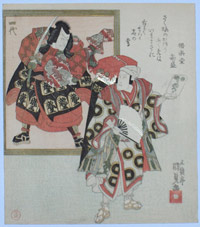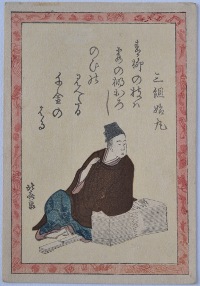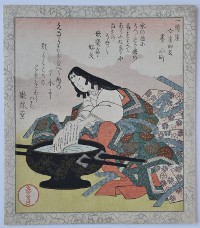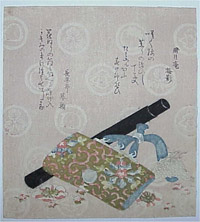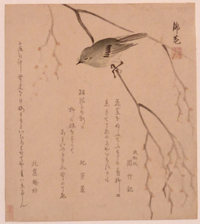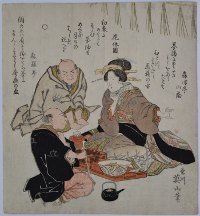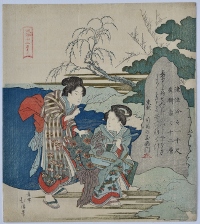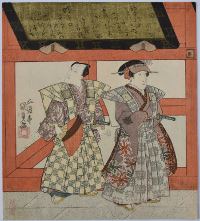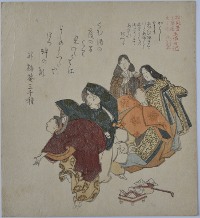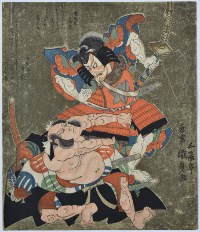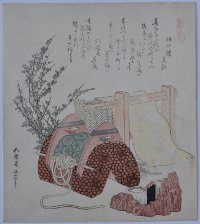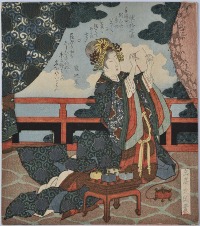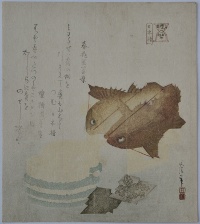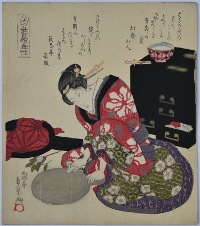Utagawa TOYOKUNI I (1769-1825)
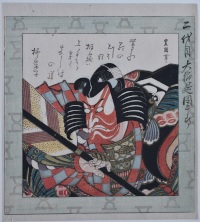
Click here to view image full size.
A surimono showing the actor Ichikawa Danjuro II as Soga no Goro Tokimune holding the giant arrow prior to sharpening it on the large wetstone from the play Yanone Goro. From a series of surimono that paid tribute to the various generations of the Danjuro family. There are two versions of this set of surimono and some ambiguity as to which is the earlier. They are known with blank borders, lacking metallic pigments and signed Ko Toyokuni hitsu (except one design signed Toyokuni II and probably issued in 1833). The other, as here, is signed Toyokuni hitsu, has metallic pigments and the emblem of the Gogawa Poetry Club around the border. The poets were also changed for this issue. It seems that the first version was issued by the Danjuro Fan Club in 1825 and that the reissue, c 1830s, was by the Gogawa. One poem by Ryueishi. The finest design from the set.
Very fine impression with metallic pigments. Fine colour and condition. Signed Toyokuni hitsu.
Status: Available
Kubo SHUNMAN (1757-1820)
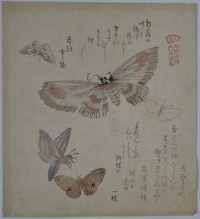
Click here to view image full size.
One of a series of surimono with title: Guncho gafu, “ Pictorial Record of a Swarm of Butterflies.” (In fact butterflies and moths.) Shunman is recognised as possibly the greatest designer of surimono and the prints from this set are amongst the most beautifully printed in this field. His family were printers and this would explain their particular excellence. In fact it is possible that Shunman engraved and printed himself which would account for his seal on other artists’ surimono. Issued c 1810s by the Kasumi-ren poetry club. (Their seal above the signature, top right, Kasumi-ren guncho gafu.) There are copies of the prints from this set which can be very misleading. Two other genuine impressions are in Harvard, 1933.4.1375 and the Met, JP2356.
Very fine impression. Fine colour. Slight discolouration and crinkling at the corners, otherwise good condition. Signed Sho Shunman sei.
Status: Available
Utagawa KUNIYOSHI (1797-1861)
Click here to view image full size.
Shinba ren Uogashi ren Ichikawa Sansho e kore o okuru. Of the utmost rarity: A large surimono commissioned by the Shinba and Uogashi poetry clubs of Nihonbashi to commemorate the kabuki actor Ichikawa Sansho. Sansho was one of the haigo (poetry name’s) of Ichikawa Danjuro VIII (1823-54). This print was presented to Danjuro in May 1849, and he subsequently went to see his father, Ichikawa Ebizo (Danjuro VII), who had been banished to Osaka, as the red image of Shoki on the nobori represents Ebizo. These banners were flown on the Boy’s Festival (Tango no sekku) on the fifth day of the fifth month outside the homes having male children under the age of seven. The large carp kite was also flown at this time and represents perseverance. This impression has the poems of the Shinba circle. It is also known with poems of the Uogashi club. Another impression is in the Springfield Museum of Fine Arts, Bidwell collection, Utagawa Kuniyoshi, 1980, no. 195. This impression is illustrated elsewhere. Also Kuniyoshi, Juzo Suzuki, Heibonsha Ltd, 1992, no 461, and Kuniyoshi, Nikkei Inc. 2011, no 295. An impression has also come up at auction.
Fine impression with heavy gold on the top of the banner. Fine colour. Restored wormholes and restoration along the vertical laid lines. Signed Ichiyusai Kuniyoshi e.
Status: Sold
Totoya HOKKEI (1780-1850)
Click here to view image full size.
A still life surimono showing a right-eye flounder or flatfish, Karei, and a red bream, kaneme-tai. And small unidentified vegetables. Provenance: A slip from a catalogue on the back indicates that it comes from a Paris sale, probably early 20th century describing it as Limande et dorade. Hokkei is best known for his surimono. He was originally a fishmonger, hence his name Totoya, and also accounts for the number of surimono he designed with fish and shells. Extremely rare.
Fine impression and colour with mica on the bream. Minor soil, otherwise very good condition. Signed Hokkei.
Status: Sold
Utagawa KUNISADA (1786-1864)
Click here to view image full size.
A long surimono showing a fan with an image of Ichikawa Danjuro VII as Soga no Goro in the play Yanone, “The Arrow Head.” To the left a fan shape with a poem by Sansho VII (Ichikawa Danjuro VII) and irises. Extremely rare. This impression sold by me in 1997. Issued c 1814. These long surimono were published with the poems attached but were invariably removed by collectors as being a distraction from the image.
Very good impression and colour. Minor soil, otherwise good condition. Signed Gototei Kunisada ga. A name bottom left corner reads Onishi Tokuzo II.
Status: Sold
Totoya HOKKEI (1780-1850)
Click here to view image full size.
A surimono showing the Japanese Buddhist goddess Benten, as always with her lute, and a monkey and rat holding a scroll showing the short months (2,4,7,9,12) for the Rat year, 1828. Benten (Hindu: Saraswati) originates from India via China. She is also one of the Seven Gods of Good Fortune. A fukujuso plant in a pot to her right. Poems by Ganjotei Shirataka and Tetsujoan Maori.
Very fine impression with extensive silver and gold. Signs of mounting au verso, otherwise very good condition. Fine colour. Signed Hokkei.
Status: Sold
Utagawa KUNISADA (1786-1865)
Click here to view image full size.
A complete setsugekka koban surimono-style set of triptychs: Snow, Moon, Flowers. Each triptych shows actors in the snow (from left: Matsumoto Koshiro V; Iwai Kumesaburo II; Ichikawa Danjuro VII); in moonlight (Iwai Shijaku I; Bando Mitsugoro III; Iwai Hanshiro V); and admiring the spring blossoms ( Onoe Kikugoro III; Segawa Kikunojo V; Seki Sanjuro II). Published by Mikawaya Seiemon (who specialised in these koban surimono-style prints) c 1825. Extremely rare. One other complete set is in the Harvard Art Museum, acquisition numbers 206831; 207183; 207139.
Very fine impressions. These are not true surimono, although they are listed in some books and catalogues as such. However, they are printed with the same delicacy with beautiful blind-printing. Fine colour. Small nicks out of the corners, otherwise fine condition. Each sheet signed Oju Kunisada ga.
Status: Sold
Yanagawa SHIGENOBU II (active c 1824-1860)
Click here to view image full size.
A surimono: Sono shichi – Nushi aru hana, “The Flower with an Owner.” Round 7 from a series Hana-awase, “A Flower Competition.” Usually a poetry competition to produce the best poems using different flowers, although in this instance the flowers are actually familiar terms incorporating the word “flower.” A princess holding a helmet, with two others on the ground. Published c late 1820s for the Sugawararen Club. Poems by Kakumu Yamamori, Makinoya Ototaka and Ryuhosha Kiyokaze.
Fine impression, colour and condition. Signed Yanagawa Shigenobu.
Status: Sold
Yashima GAKUTEI (1786-1868)
Click here to view image full size.
A surimono showing plum blossom and fugu (blowfish or puffer, Fugu pardalis). These fish are infamous for being poisonous, mainly from their liver and are expensive delicacies in the winter. Extremely rare: Two other genuine impressions are in the Museum of Fine Arts, Boston, acc. no. 21.9297 and illustrated in Coloured in the Year’s New Light, Japanese surimono from the Becker collection, Daniel McKee, 2008, Johnson Museum of Art, Cornell University, no. 15. There are also copies of this surimono which is how one will come across it. Poems above by Mahmansai Iedaru and Kanayaen Mahiro. Published c. late 1810s. Gakutei is best known for his surimono but he was also an accomplished painter and produced a fine set of landscape prints of views of Tempozan.
Fine impression and colour. One small repaired wormhole, otherwise very good condition. Signed Gakutei Harunobu.
Status: Sold
Taiso YOSHITOSHI (1839-1892)
Click here to view image full size.
A vertical oban diptych showing the renowned swimmer and fishmonger Rorihakucho Chojun grappling underwater with the famous (but non-swimmer) warrior Kokusenpu (“Black Whirlwind”) Riki. The result of Chojun challenging Riki to a fight after his gang attempt to rob some fishermen. They eventually become friends. Rorihakucho Chojun Kokusenpu Riki ochude tatakau zu. Published by Matsui Eikichi early 1887. This is the first edition without publisher or date. It was then issued with this information and then re-published by Hasegawa Tsunejiro in September 1887. This is most likely a proof impression with extra large margin on the left. The finest impression I have seen of this design.
Superb impression, colour and condition. Signed Oju Yoshitoshi ga.
Status: Sold
MADOYA (Active c. 1830s)
Click here to view image full size.
A surimono by an Osaka artist from a series with title Hasoku shunsho juhachi-ban no uchi,”Eighteen Pieces Praising Spring Near the Water.” Sub-title: Tenpozan (the name of the new port in Osaka Bay). Shows a girl in a boat beside the prow of a larger vessel. The Osaka port sign is seen in the background. Three poems above. Rare.
Fine impression and colour with touches of gold and silver. Very slightly trimmed left, otherwise fine condition. Signed Oju Madoya hitsu.
Status: Sold
Totoya HOKKEI (1780-1850)
Click here to view image full size.
Hokkei, a pupil of Hokusai, is best known for his fine surimono. This rather enigmatic example shows an ox being led by a farmer and his son. There appears to be a festival element in the headgear. Presumably issued for the Ox year (1829). The poetry club logo, top left, is in the form of an ox. Another impression is in Harvard, 1933.4.1981, and another example is in the MFA, Boston, 11.20608. Interestingly, this example lacks the aforementioned ox seal: Possibly there was a commercial printing of the surimono.Two poems above. Rare.
Fine impression. Fine colour with extensive silver. Fine condition. Signed Hokkei.
Status: Sold
Totoya HOKKEI (1780-1850) (Attrib. to.)
Click here to view image full size.
A surimono showing a new year’s throng of musicians, a monkey trainer, a samurai and children with a large kite. Possibly one sheet of a diptych or triptych. A beautiful example of the art of the surimono. Rare.
Superb impression. Fine colour with extensive silver, gold and blind-printing.
Status: Sold
Utagawa TOYOHIRO (1773-1829)
Click here to view image full size.
A surimono showing a mechanical doll with movable eyes and mouth. It holds two puppets of Chinese boys, karako, playing cymbols. These automata, karakuri ningyo, were popular in Edo-period Japan and those made by Takeda Omi were the most famous. The doll stands on a small table with a flowering cherry tree. Issued c 1810s. Rare.
Fine impression and colour with extensive gold, silver and burnishing. Fine condition.
Status: Sold
Yashima GAKUTEI (1786-1868)
Click here to view image full size.
A surimono showing two dancers performing the Sparrow dance, Suzume odori. From a set of six prints forming a hexaptych (this being the top left sheet) for the Katsushika Poetry Club, Katsushika rokubantsuzuki, c 1827-8. The vertical gold bands suggest a birdcage.Illustrated in Surimono, in the Rijksmuseum, Amsterdam, Matthi Forrer, 2013, no. 455.
Fine impression and colour. Minor soil, otherwise good condition.
Status: Sold
Katsushika HOKUSAI (1760-1849)
Click here to view image full size.
A surimono, Watakuri uma, from a series Uma tsukushi, “Horse Series.” The set of at least thirty surimono was issued by the Yomo-gawa Poetry Club for the Horse Year, 1822. The title alludes to the appearance of the watakuri, “cotton gin” usually seen atop a wooden sawhorse-like stand. Also shown is a wooden saddle on a leather base, a smoking set and branches of white plum. Poems by Matsuchi, Kagetsudo and Matsunoya Sononari. Rare.
Fine impression and colour with silver, gold and blind-printing. Very good condition. Signed Fusenkyo Iitsu hitsu.
Status: Sold
Utagawa KUNISADA (1786 – 1865)
Click here to view image full size.
The actor Ichikawa Danjuro VII as the medicine peddler in the play Uiro-uri and Ichikawa Danjuro IV in the votive panel above as Kagekiyo in the play of the same name. Both these plays are included in the Kabuki Juhachiban ” Eighteen Favourite Plays” chosen to illustrate the special art of the Danjuro line of actors. The lower half of Kagekiyo’s costume includes the characters “Dragon King” “Ryu-o” suggesting the date 1820. The upper half has the Gogawa hour-glass poetry club symbol.
Very fine impression. Fine colour with gold and silver. Fine condition. Signed Kunisada ga.
Status: Sold
Katsushika HOKUSAI (1760-1849)
Click here to view image full size.
A koban surimono from a kyoka set ( of one hundred ? ) published c. 1805. Shows a kyoka poet with poem by Mikumi Himemari. Seemingly the only large group illustrated is in the Katsushika Hokusai Exhibition from The Peter Morse Collection, Ukiyo-e Ota Memorial Museum of Art, 1988, no . 167 ( this design on page 106 ). Rare. Ex collection Tony Strauss-Negbaur ( seal au verso ).
Fine impression, colour and condition. Signed Hokusai ga.
Status: Sold
Yashima GAKUTEI (1786-1868)
Click here to view image full size.
A surimono from a fine set of eight prints: Ichiyoren bunbo shiyu, “Four Companions of the Writing Studio for the Ichiyo Circle.” Issued c 1827 for the Ichiyoren poetry club. The set alternates Chinese and Japanese subjects with the literati tradition of brush, ink, inkstone and paper. In this case: Sumo Komachi, “Ink and Komachi.” Ono no Komachi being the famous mid-ninth century poet and it shows her washing a poetry anthology which included a poem plagiarized by another poet who accused her of stealing it. The ink ran proving her innocence. Poems by Karakutei Kobun and Karindo.
Very fine impression with blind-printing, gold and silver. Fine colour. Slight crease, otherwise fine condition. Signed Gakutei.
Status: Sold
Anonymous (1821)
Click here to view image full size.
A still life from a set of six prints for the Iwagaki Club: Iwagaki-ren rokuhira no uchi. Shows a tobacco pouch, telescope and snake netsuke (for snake year 1821). There appear to be at least three states of this lovely surimono.
Fine impression and colour with gold and silver on the pouch. Minor rubbing, otherwise very good condition.
Status: Sold
Totoya HOKKEI (1780-1850)
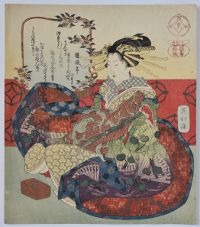
Click here to view image full size.
Originally a fishmonger (hence the go Totoya). Studied painting under Kano Yosen’in and then became one of Hokusai’s best pupils. Produced excellent surimono such as here showing a sumptuously attired courtesan representing Kyoto from a set of three surimono Sangoku-shi no toen ketsugi, a History of the Three Kingdoms. (A play on the Chinese states of Wei, Shu and Wu during AD 220-280, but here being Kyoto, Edo, Osaka.) Produced for the Shipporen (“Seven Treasures”) Kyoka Club c 1827. Their emblem top right and also incorporated into the background and on the box bottom left. Extremely rare.
Superb impression, colour and condition with extensive silver and gold. One of the finest surimono I have catalogued. Signed Go Hokkei.
Status: Sold
Yashima GAKUTEI (1786 [?]-1868)
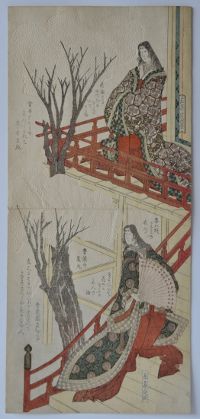
Click here to view image full size.
An uncut vertical surimono diptych showing two young women in court finery from the Heian period (794-1185). This being considered the finest and most cultured period in Japanese history. One stands on a balcony, the other on steps leading to the balcony overlooking a flowering cherry tree. Extremely rare: The separated design is in the MET, JP2062 and JP2061as well as them having an uncut example, JP1101. These vertical diptych designs were printed on a single sheet of hosho from a single block but with a horizontal crease between what would be the two separate surimono of conventional size. There are also two vertical diptych designs known which form a four surimono picture but these are even rarer.
Extremely fine impression, colour and condition. Extensive silver and blind-printing. Signed Gakutei Sadaoka hitsu and Gakutei Sadaoka.
Status: Sold
Ryuryukyo SHINSAI (c1764-1823)
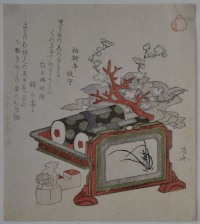
Click here to view image full size.
A surimono still life showing two handscrolls, a small screen, a branch of coral, a branch of plum blossom and two seals. (Coral and plum blossom are associated with the new year.) One of the seals has a tiger on top, possibly indicating this surimono was issued for the Tiger year 1818. From a series of still life surimono produced by the Taiko-gawa (Drum Poetry Group), their seal top right. Shinsai was one of Hokusai’s best pupils and is primarily known as a surimono designer. In fact, this surimono seems to have been reissued without the Drum seal and different poems. (See The Art of Surimono, Roger Keyes, Sotheby, 1985, no. 286, p. 334.) One poem by Rankotei Dondontei.
Very fine impression. Fine colour with gold and silver. Small crease top right and minor signs of mounting au verso, otherwise very good condition. Signed Shinsai.
Status: Sold
Utagawa KUNISADA (1786-1865)
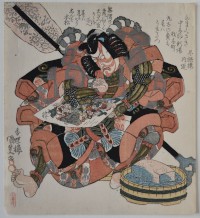
Click here to view image full size.
A surimono showing the actor Ichikawa Danjuro VII in the role of Soga no Goro holding a print of the shichifukujin in the takarabune. A parody of the Yanone no Goro story: Yanone means “arrowhead” and is one of the eighteen famous plays in the Danjuro canon, belonging to the Soga Brothers cycle. He is shown with the over-large arrow and whetstone for sharpening it. Poem by Jingoro Uchichika. The printer’s seal Kozensai bottom left. (The same seal appears on a number of other Danjuro VII surimono.) He also appears in the role of a poet and possibly belonged to the Mimasu-ren poetry club that supported the Danjuros. A very fine surimono.
Very fine impression. Fine colour and condition. Signed Kochoro Kunisada ga with double toshidama seal.
Status: Sold
Hishikawa SORI (Active 1797-c.1813)
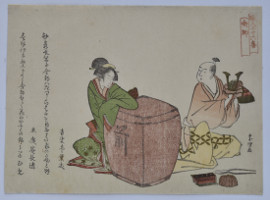
Click here to view image full size.
A samurai helmet maker (kabuto) from a series of surimono Shokunin sanjurokuban, “Thirty-six Poets as Craftsmen.” Issued for the Asakusagawa Club in 1802. Hand-stamped series title top right. Sori was a pupil of Hokusai originally called Soji with Hokusai passing on the name to him. Shows a beauty leaning on a cabinet that holds armour. On the right the craftsman holding a helmet. The set was reissued in a slightly different format in 1803.
Fine impression, colour and condition with touches of gold. Signed Sori ga.
Status: Sold
Yashima GAKUTEI (1786 ?-1868)
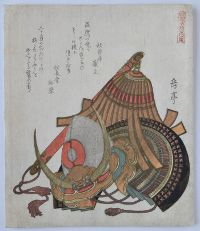
Click here to view image full size.
Best known for his surimono although he produced fine paintings, some good landscapes and was also known as a poet. A surimono, one of a set of two on the martial arts of Japan and China, this obviously being Japan: Wakan butoku no uchi. Shows a helmet with a demon’s head and a red-lacquered baton with leather strips. These are usually the accoutrements of the famous general Kato Kiyomasa (1562-1611). Two poems by Shusetsutei Kuranushi and Shuchodo Monoyana. Issued c. 1820. Three collector’s seals au verso including Kunsthalle Bremen. Rare.
Very fine impression and colour with extensive gold, silver and bronze. Light edge tape on back, otherwise very good condition. Signed Gakutei.
Status: Sold
Yashima GAKUTEI (1786 ?-1868)
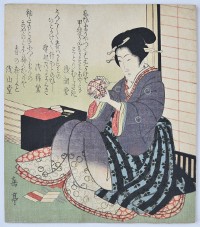
Click here to view image full size.
Best known for his surimono although he produced fine paintings, some good landscapes and was also known as a poet. A surimono showing a young mother making a temari ball. This form of folk art arrived from China in the 7th c. The balls were given to children on New Year’s day. Their production evolved and became more intricate with time, some having bells or rice placed in them so they became audible or had a mother’s wish secreted inside. A beautiful and extremely rare surimono: At the moment I cannot locate another impression.
Very fine impression. Fine colour. Slight vertical crease strengthened au verso, otherwise very good condition. Signed Gakutei.
Status: Sold
Utagawa TOYOKUNI I (1769-1825)
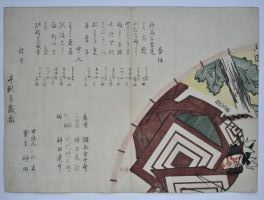
Click here to view image full size.
A large surimono which shows Danjuro VII in Shibaraku on a fan on the right. He did, in fact, perform Shibaraku in the 11th month kaomise performance at the Morita-za theatre in 1812 (which fits the style of Toyokuni’s signature). However, the rest of the design appears to be a program for a dance recital with the names of dances and below the names of Nagauta School musicians and Hayashi percussionists. This makes the exact reason for the print difficult to determine. Extremely rare: Possibly the only known impression.
Very good impression and colour. Slight surface soil and vertical fold (as usual), otherwise very good condition. Signed Toyokuni ga.
Status: Sold
KINKO
Click here to view image full size.
A surimono of what may be a Japanese bush warbler ( uguisu ), the harbinger of spring, perched on a weeping cherry branch.Three poems below.
Fine impression and colour. Slight signs of mounting au verso, otherwise very good condition. Signed and sealed Kinko. Seal of engraver Shiho Sanshi bottom left.
Status: Sold
Kikugawa EIZAN (1787-1867)
Click here to view image full size.
A surimono showing a game of rock-paper-scissors, although this might be a variant called Kitsune-ken, with fox-hunter-village chief. The game originates (as so much in Japan) from China and eventually made its way to the west. This was (and is) a dangerous game to play with ladies who entertained as they seldom lost. Published c 1820s. Eizan designed few surimono and this is rare.
Fine impression. Very good colour and condition. Signed Kikugawa Eizan hitsu.
Status: Sold
Totoya HOKKEI (1780-1850)
Click here to view image full size.
A surimono showing two beauties by the pond at Tsunowazu Kumano Shrine in Yotsuya. The title is: Yotsuya Juniso, referring to the twelve shrines at Tsunowazu in Yotsuya. The poem on the large stone is by Shibanoya and refers to the peacefulness of the place with the willows and water. The other writing directs visitors to the cool of the nearby waterfall and the Unju forrest.
Fine impression with silver and gold. Fine colour and condition. Signed on request, Motome ni ojite Hokkei fude.
Status: Sold
Utagawa KUNISADA (1785-1865)
Click here to view image full size.
A surimono showing the actors Ichikawa Monnosuke III (right) and Ichikawa Danjuro VII walking in the emado of Asakusa Temple in Edo. This was a pavilion at the Shinto shrine used for displaying votive tablets. This seems to be part of a three or five sheet set showing a continuous procession of Ichikawa actors at the shrine. Provenance: From my Catalogue 15, 1975, no. 67.
Fine impression with extensive gold and silver. Fine colour and condition. Signed Gototei Kunisada ga.
Status: Sold
Kubo SHUMMAN (1757-1820)
Click here to view image full size.
A surimono showing court figures dancing from a series: Shofudai Hisakataya Bunbunsha Tosa Nikki, “The Tosa Diary for the Shofudai, Hisakataya and Bunbunsha Poetry Groups.” Issued late 1810s. For another from this series see: Jewels Of Japanese Printmaking: Surimono Of The Bunka-Bunsei Era 1804-1830, Joan B. Mirviss, Ota Memorial Museum of Art, 2000, no. 85, p. 131. Rare: Possibly the only known impression.
Fine impression. Very good colour. Lightly backed, otherwise very good condition. Artist’s seal Sho Shumman.
Status: Sold
Utagawa KUNISADA (1785-1865)
Click here to view image full size.
A surimono showing Ichikawa Danjuro VII and Bando Mitsugoro III as Soga no Goro and Asahina no Saburo in the armour-pulling (kusazuri-biki) scene from the play Tsukisenzu haru gohiki Soga. Issued 1827. The story relates how Soga no Goro was feasting at a banquet when he learns of a plot to assassinate his brother, Juro. He rushes off to don his armour. Asahina, the liege of his enemy, tries to prevent him by pulling at his armour. Poems by Yukinoya Takane and Hoshitei Masunari. Rare.
Fine impression with extensive silver and gold. A gold ground. Fine colour. Some loss of the gold ground as is the case with other known impressions of this surimono. This appears to be the best preserved copy. Very good condition. Signed Oju Gototei Kunisada ga.
Status: Sold
Katsushika HOKUSAI (1760-1849)
Click here to view image full size.
A surimono, Umazakushi, showing a saddle and cotton-gin from Watakuri uma, “A Series of Horses.” Issued for the Yomogawa club, 1822. Shows a horse’s saddle, a cotton-gin, basket of cotton floss and a branch of plum. A smoking set in the foreground. This set followed on from the success of the Shell surimono series issued in 1821. Twenty eight designs are known. The title (in a red gourd) top right is hand-stamped. Rare.
Fine impression with silver, gold and blind-printing. Fine colour. Minor soil, otherwise very good condition. Signed Fusenkyo Iitsu hitsu.
Status: Sold
Takahashi CHIHARU (1777-1859)
Sold
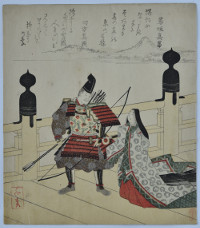
Click here to view image full size.
A surimono in Yamato-e style showing Otohime and Tawara Toda on the long bridge at Seta. There are different versions of this popular legend. One has it that Otohime, the Dragon Princess, had an enemy in the form of a giant centipede that lived and poisoned Lake Biwa. It had also killed two of her sons. She begs Tawara Toda Hidesato, a famed archer, to kill it. This he does and she rewards him in the Dragon Palace with silk, a sword and armour, a temple bell, and a bag of rice. The silk and rice are to last forever, however much is used. Hence his name Tawara Toda, “Rice-bag Toda.” Probably issued for Dragon year 1832.
Fine impression, very good colour and condition. Signed Chiharu.
Status: Sold
Ryuryukyo SHINSAI (Active c 1799-1823)
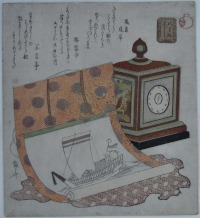
Click here to view image full size.
A surimono showing a scroll with a painting of a Takarabune ship and an enameled Persian clock (with Arabic numerals). Norizome, “Maiden Voyage [of the New Year].” The Takarabune, “Treasure Ship” is associated with the new year and carries the Seven Lucky Gods (Shichifukujin) with their treasures. Shinsai was a pupil of Hokusai and is best known for his surimono prints. Issued in 1822 by the Taiko-gawa, “Drum Poetry Group” with their emblem top right. Three poems by Shikishishima Michikusa; Ume no Sugatame; Fugentai. Another (trimmed) impression is in the MET, JP2116.
Fine impression. Very good colour. Minor soil, otherwise very good condition. Signed Shinsai.
Status: Sold
Yashima GAKUTEI (active 1815-1852)
Click here to view image full size.
A surimono showing a Chinese lady threading a needle on a balcony. First issued in Osaka for the Drum Group, c 1824. This is the excessively rare first edition with the blue sky and clouds; verses by two Osaka poets, and the coloured thread is connected to the spool on the floor. Another genuine impression is in the Metropolitan Museum of Art, accession number JP2090. In the second state the verses are replaced by Edo poets. In the third state the blue sky is replaced with a gold ground and there is a hand-stamped title. There are clever copies of this surimono produced in the 1890s. This is possibly the only other genuine impression of the first edition extant.
Fine impression and colour with areas of gold. Fine condition. Signed Gakutei Sadaoka hitsu. Ex Hayashi collection, seal bottom right.
Status: Sold
Hotei GOSEI (Active c. 1804-1835)
Click here to view image full size.
A surimono showing a still life of fish and utensils from a fine and rare set Toto meisho awase, “Famous Attractions of the Eastern Capital.” The series title in a cartouche in the shape of the character “go” representing the Go-gawa Club. Each surimono shows something related to the location in Edo, in this case the sub-title is Nihonbashi. What the connection is is not obvious to me; perhaps the fish were a delicacy in restaurants which crowded round the bridge. Gosei was a pupil of Hokusai who gave him the name Hokuga which he changed to Gosei around 1810. Published c. 1820. Possibly the only known impression.
Very good impression and colour. Some slight soil, otherwise good condition. Signed Gosei hitsu.
Status: Sold
Utagawa SADAKAGE (active c. 1818-1844)
Click here to view image full size.
A surimono, Kinsei, “Metal” from Gobantsuzuki, “A Set of Five” surimono based on the five elements: Wood, Fire, Earth, Metal and Water. Shows a woman polishing a metal mirror. Published c. mid-1820s. The set was designed for a group led by the poet Shakuyakutei whose plum-blossom emblem is seen at the top of the title cartouche.
Superb impression, colour and condition. Extensive silver and gold. Mint condition. Signed Gokotei Sadakage ga.
Status: Sold
